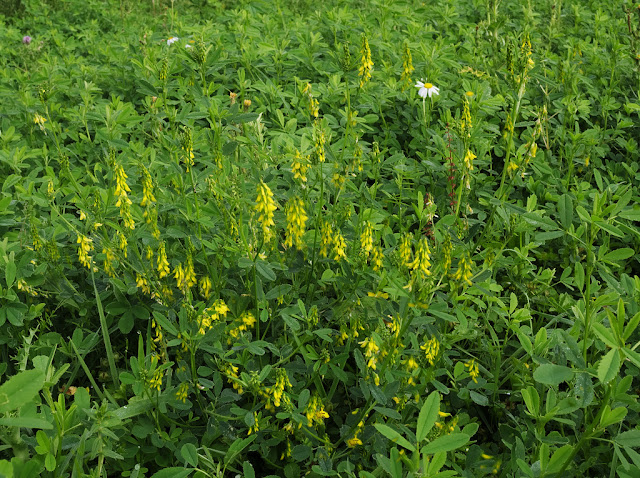 |
| Meadow by Fen Road Exit - 15 July 2015 |
In amongst the grass were patches of hedge parsley, which looks much like stunted cow parsley, but is a separate species flowering later than its larger cousin.
 |
| Meadow by Fen Road Exit - 26 July 2015 |
Thistles were also very common in the same patch.
 |
| Meadow by Fen Road Exit - 15 July 2105 |
The area did yield one surprise: a patch of lady's bedstraw. I think this is the only place that this plant can be seen in the park.
All Change
 |
| Meadow by Fen Road Exit - 15 July 2015 |
It was the smaller part of this area which was not covered by the taller grasses that prompted me to write this post. The image above shows the area full of cinquefoil and field bindweed. It is the sort of scene that is incredibly difficult to capture in a photograph. To the naked eye, the bindweed stands out from a mass of yellow cinquefoil flowers. The harsh reality, as revealed by the camera, is that most of the area is green sparsely punctuated with yellow with a few pink and white highlights.
But, for me, the real interest in this area is complete change that occurred in just eleven days.
 |
| Meadow by Fen Road Exit - 26 July 2015 |
The whole area has been taken over by ribbed melitot, with no sign at all of either the bindweed or cinquefoil seen previously. There was a hint of things to come in the earlier image, in that, on close inspection, ribbed melitot leaves are visible.
With the twenty twenty vision of hindsight, I would have paid more attention to this area earlier. Had there already been a similar transition? Is this an annual occurrence, or is this a one off and the ribbed melitot is now the dominant plant? I shall watch more closely next year.
 |
| Meadow by Fen Road Exit - 26 July 2015 |
The one plant that was not completely overwhelmed by the new regime was scentless mayweed.
Continuing my interest in the origin of plant names, I was interested to find out why a plant flowering in July is called mayweed. Was it a case of confusion with another similar plant? Apparently, the plant gets its name from the Danish 'may' meaning maiden and not from the month of flowering, and was so called because it was used to treat complaints of young ladies.
Next: Water
No comments:
Post a Comment